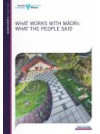What works with Māori: What the people said draws together a significant body of work, undertaken by the Commission as part of its Whānau Rangatiratanga Work Programme: He Ara Whakamua, Building pathways together to the future.
In 2011-12, the Commission held a series of wānanga throughout the country to provide an opportunity for whānau, hapū, iwi, Māori organisations and all those working with Māori, to workshop how, in their experience, kaupapa Māori processes, tools and models contribute to whānau rangatiratanga. Over 600 people attended these wānanga. A literature scan covering material gathered over a year is included within this report.
What Works With Māori: What the people said integrates reports and indepth analysis from each of the wānanga, with the relevant literature for the Whānau Rangatiratanga Outcome work programme set out in the Families Commission Statement of Intent 2011–2014:
- whānau are empowered to achieve rangatiratanga
- whānau have a better understanding of, and access to, a range of kaupapa Māori-based tools and services, and others’ experiences of transformational change.
Whānau rangatiratanga is the approach adopted by the Commission to deliver better public services and better public result areas in its work with whānau. Whānau rangatiratanga, or whānau empowerment, is the concept that has framed this project. Whānau sit at the complex nexus between the social configuration of whānau, hapū and iwi, and the philosophical tradition articulated through Māori cultural knowledge, methods and practice. At this nexus ‘being Māori’ is a lived reality in which whānau negotiate authentic pathways to new futures. As sites of struggle, these pathways are less dependent on state intervention than has historically been the case.
The literature complements the wānanga and identifies critical success factors leading to positive Māori outcomes, such as: relationships and collaboration; measurement; kaupapa Māori; putting whānau at the centre; the need for good data and research; aspirations and expectations; high-quality services; the need for adequate funding; innovation and transformation; tino rangatiratanga; building capacity and capability; and best practice.
The literature notes that these factors are not found in isolation – it is their combined influence that leads to success. Kaumātua wisdom informed this project from a bottom-up perspective.
In presenting the analysis of the themes from the wānanga, Dr Irwin presents the model: Nation Building in Aotearoa New Zealand: An Interpretive Framework. The framework discusses both Treaty partners at the three key societal levels of each Treaty partner: structural (iwi and government), institutional (marae, whānau, hapū and local government) and interpersonal (citizenship). Dr Irwin notes that while public policy may be developed at the structural level, it is implemented at the institutional/agency level and impacts on New Zealanders at the personal level.
This project has multiple publications, which can be found on the Superu website above.
Purpose
This report contributes to the Whänau Rangatiratanga Outcome set out in the Families Commission Statement of Intent 2011–2014:
- whānau are empowered to achieve rangatiratanga
- whānau have a better understanding of, and access to, a range of kaupapa Māori-based tools and services, and others’ experiences of transformational change.
The objectives of this research were to research kaupapa Māori processes, tools and models that contribute to whānau rangatiratanga; and use kaupapa Māori methods (wānanga) to research and explore the kaupapa of building pathways together to the future.
The research question was: How do kaupapa Māori processes, tools and models contribute to whānau rangatiratanga?

